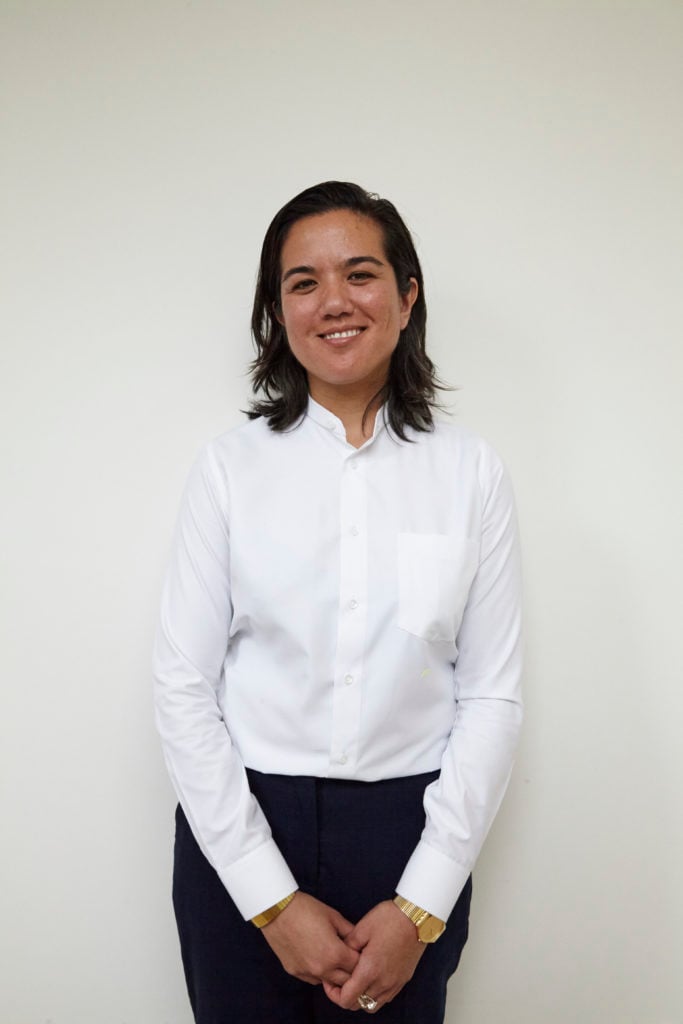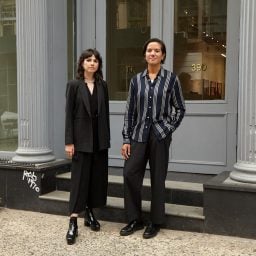Since opening in 2012 Jasmin Tsou’s gallery, JTT, has developed a reputation for hosting some of New York’s most forward-thinking exhibitions, and representing some of the art world’s most exciting young talents.
For a brief moment Tsou seemed destined to be an artist herself, enrolling at New York University’s studio art program where she met Carol Bove, who was teaching. Amid a struggle to find her artistic voice, she pivoted towards other positions within the art world; first with a brief stint teaching at NYU’s Shanghai outpost, then as an employee at Kimmerich and Maccarone galleries, before eventually taking the plunge and opening her own shop.
Early exhibitions with Bill Walton, Borna Sammak, and Becky Kolsrud set the scene for a rigorous, cutting edge, and risk-taking program. Tsou also gave early shows to stars like Diane Simpson, Elaine Cameron-Weir, Jamian Juliano-Villani, Issy Wood, and Sam McKinniss. The art world soon took notice, and several of the artists she helped nurture have been included in major biennales, articles, and publications (Cameron-Weir, Juliano-Villani, and Sable Elyse Smith are in this year’s Venice Biennale).
After 10 years in business, the gallery appears to have reached mid-size maturity with the inauguration in May of an 8,000 square foot space in Tribeca, a burgeoning gallery enclave in lower Manhattan. Despite the scaled-up new digs—which include a flashy exhibition space, a cavernous basement storage area, and a yet-to-be-completed office—Tsou hasn’t embraced the mid-size label, and still refers to her operation as “young” or “small” over the course of our conversation.
On a damp and stiflingly humid New York summer day, I made my way downtown, armed with both sunglasses and an umbrella, to meet Tsou at her new headquarters on Broadway. The dealer’s office is still under construction, so we sat down in the coffee shop next door to discuss her career to date, the importance of collaboration, and the dangers of the unrestricted financializaiton of the art market.
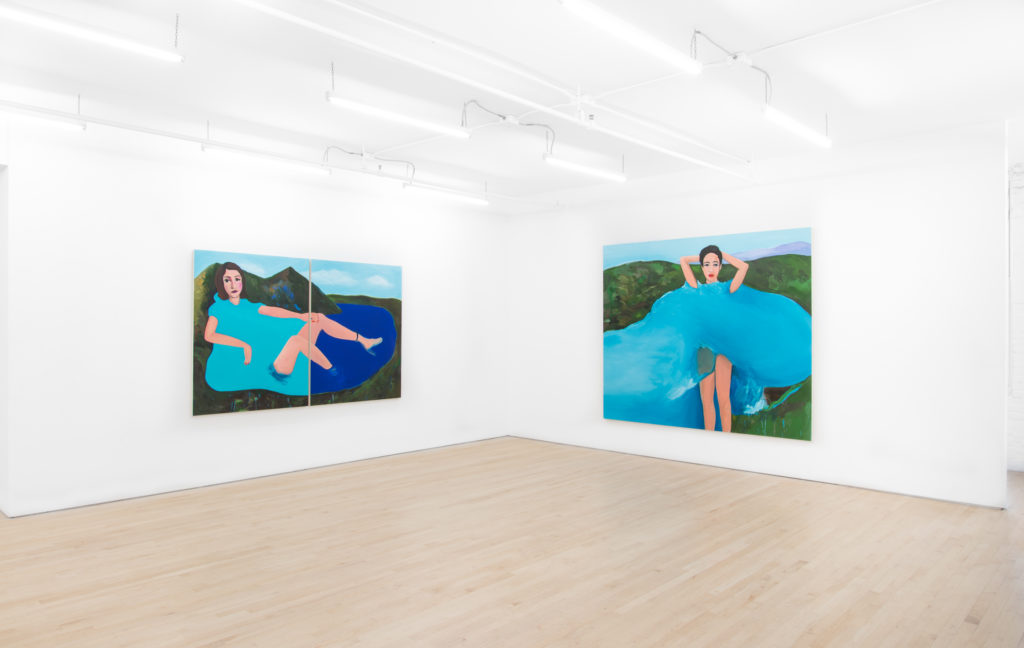
Installation view, Becky Kolsrud: Allegorical Nudes at JTT, New York. Images courtesy of the artist and JTT.
Your first foray into the commercial art world was when you got a job at Maccarone on the recommendation of Carol Bové in 2008. How was that introduction to working at a for-profit gallery?
Michelle was a very interesting person to work for. I had a chance to work with artists that were entering really exciting moments in their careers. It was really fun to watch that happen, and to be a part of shows with Carol Bové, Paul McCarthy, Nate Lowman, and Alison Gingeras—it taught me a lot.
Later you worked for Kimmerich Gallery, what did you learn from that experience?
Michelle and Dennis are totally opposite personalities. Michelle was very passionate, and I think I learned the importance of understanding that it’s a very vulnerable thing to put on an exhibition for an artist, and I like to think that we try to meet the artist where they’re at in that experience.
Dennis was very interested in doing a good job for people and took his role as a dealer very, very seriously. He was very serious about making sure that the numbers made sense and that the artists were still walking away with money and that the gallery wasn’t in debt.
You opened up your own space in 2012. How did you start the business? Did you have investors? How did you make it work financially in the early days?
I was very lucky that a couple of things worked out. I started the gallery with a very small amount of my own money, and we kept our expenses extremely low for the first four or five years. Most of that time I was the only employee or there was one other person.
In the beginning if you have just one or two artists that do very well, that can be a life changing experience as a business owner. I also had small loans from people who believed in what we were doing, but I never had any investors. Nobody ever invested or bought a share of the business, ever.
You have a reputation for working with really forward-thinking artists. What do you look for in the artists you show or represent? And how do you discover the artists that you work with?
I feel like I meet artists in a similar way to how I meet friends, and many of the artists I’ve shown are part of my social circle, definitely Elaine [Cameron-Weir] and Jamian [Juliano-Villani].
For example, I first saw Jamian’s work on Instagram, which is hilarious because it’s like meeting the love of your life on a dating app. We did a lot of studio visits and she became part of my friend group. There’s something about the way that you talk, and understand each other, and understand each other’s humor—that’s a really important part. I don’t think I look for artists that are innovative or cutting edge because I don’t necessarily think that art is the arena for that. I think about whether this voice is an important contribution to the larger conversation in the art historical context.
You’re now coming up on 10 years in business, and you’ve grown from a tiny storefront into a mid-size gallery with a spacious headquarters in Tribeca. How has your business changed and evolved since you opened?
When I first started, the political environment was very different. Galleries were only really supporting straight, white men. It’s amazing how much things have changed in the past 10 years, but I believe these things happen in cycles, so I don’t necessarily think that this will be a forever progress story.
I’m also really worried about the way that people talk about the art market now with blockchain and NFTs, and the way that the market is very interested in making more money and finding more ways to make more money. All of this is being pitched to young galleries and artists under the guise of “hey, these are all ways that we can protect you.” But I don’t believe it.
I think that all of these things are being introduced with the goal of inventing more ways to make money. That’s not really why a lot of us start galleries. There’s a lot of things we’re interested in besides just getting rich. Everybody assumes that we’re obsessed with getting rich, but in reality a lot of us are having a really hard time financially, but we do it anyway because it gives us something that we love. For example I really enjoy spending time with artists, I really enjoy spending time with people that challenge my thinking, or help me learn something in a different way, and that’s why I’m here. I’m not here to make sure that I make money at every single other opportunity.
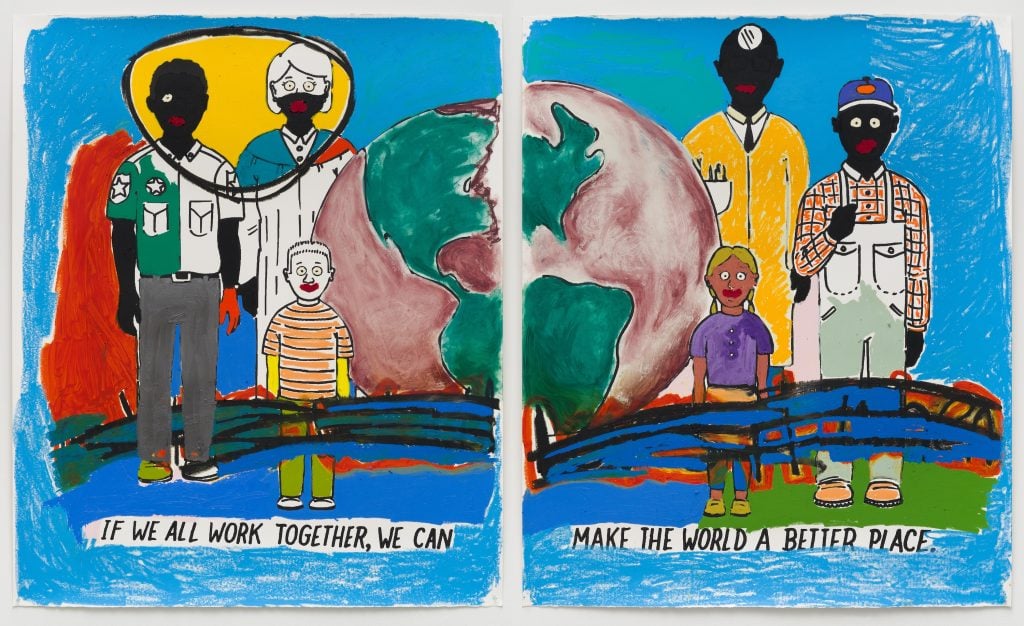
Sable Elyse Smith, Coloring Book Painting 83 (2022). Photo by Charles Benton. Courtesy of the artist and JTT, New York.
You’ve worked with a number of very “hot” artists. How have you managed the process of dispersing the work when everyone wants a painting? Do you have a method in place?
We have relationships with certain collectors who support a lot of the artists in our program, and so if they’re interested in an artist, they will probably be the ones that I will talk to first. I think that’s pretty common. The artists that work with us are young in their careers, so conversations with institutions is usually where we start. I try not to be too manipulative because I think all that stuff bites you in the butt. You have to remember that all the relationships you have with your collectors are gonna be 20 year relationships, they’re not short-term relationships.
The market for emerging artists has reached unprecedented heights. For what may be the first time, these artists have the chance to make a lot of money—fast. What mistakes do you see young artists make in this overheated environment? How do you coach them for a long career and help them avoid selling out or burning out?
The most important thing is to remind artists to trust themselves. If I’m interested in working with them, it’s because they have something unique to offer, and you have to make sure that they believe that what they’re saying is valuable.
It’s also important not to look at what other people are making but—and this sounds cheesy—to look more within. I don’t know if I necessarily say that to my artists as much as I should, but it’s something that I steer them towards. The way that we do that is by not getting too involved in what they’re making and waiting for them to come to us to tell us what they’re thinking.
One of the phenomena that has sprung up during this period is BOGO—buy one, give one—as a way to get sought-after artists’ work into institutions and ensure their longevity. What do you think of that practice?
While I’m not an economist, what I think we’re talking about here is libertarianism—nobody really wants to call it that—but we’re talking about a really large system where there’s no funding for the arts. So the only people that can really fund the arts are the collectors. The reason why the “give one get one” thing works is because institutions need these people to support them, they can’t do it without them. So my job is to make sure that the institutions get the support they need. Simultaneously what’s happening is all these collectors are getting tax write-offs. Now that is a big issue that should be discussed.
Most if not all of your artists are still with you—how can a dealer keep ahold of artists once they become successful?
One very important thing for young galleries to do is to help artists find other dealers outside of the city they’re in. It’s important to learn what an artist needs, and if you can’t provide it, find somebody who can, and collaborate with them.
Can you give some examples of galleries that you’ve collaborated with?
Sadie Coles was probably the first dealer I really significantly collaborated with on Borna Sammak’s career. That was really fun because Sadie’s a hero and I was really young when we started working together. She always spoke to me as a peer and came to me to ask for my thoughts on stuff—it was huge.
I’ve also collaborated with Vanessa Carlos [of Carlos/Ishikawa] in London a lot, showing both Issy Wood and Sable Elyse Smith. More recently we’re collaborating with Shaun Regen [of Regen Projects] on Sable Elyse Smith’s career. Shaun is another icon and is so much fun to work with because their team is so professional, and they’re very authentic people that are so cool to work with.
It’s such a competitive business—do you think there should be more collaboration among small and mid-size dealers to compete with the mega galleries?
I think it’s a little silly to think that an artist would want to work with just one gallery in multiple cities. I don’t understand the desire for these galleries to provide everything. It’s very interesting to me and is a weird psychology. “I want to be your gallerist in L.A., New York, Paris, Shanghai.” What’s up with that? It’s also very colonizing. How can one gallery be an expert in all those places?
Have you ever been tempted to go to another city?
No way! I want to work less in life at some point.
I feel like that the trend is going in the opposite direction, and everyone is trying to expand and open another space in another city.
It’s a different kind of business. It’s too disruptive if you put a lot of money into an artist to have them suddenly give inventory to another gallery. I understand that. But that’s why you have to collaborate with other galleries. It’s really hard to do without collaboration. But I guess some people just don’t want to collaborate, they just want to pump a bunch of investment into their program and line up the next five years of shows.
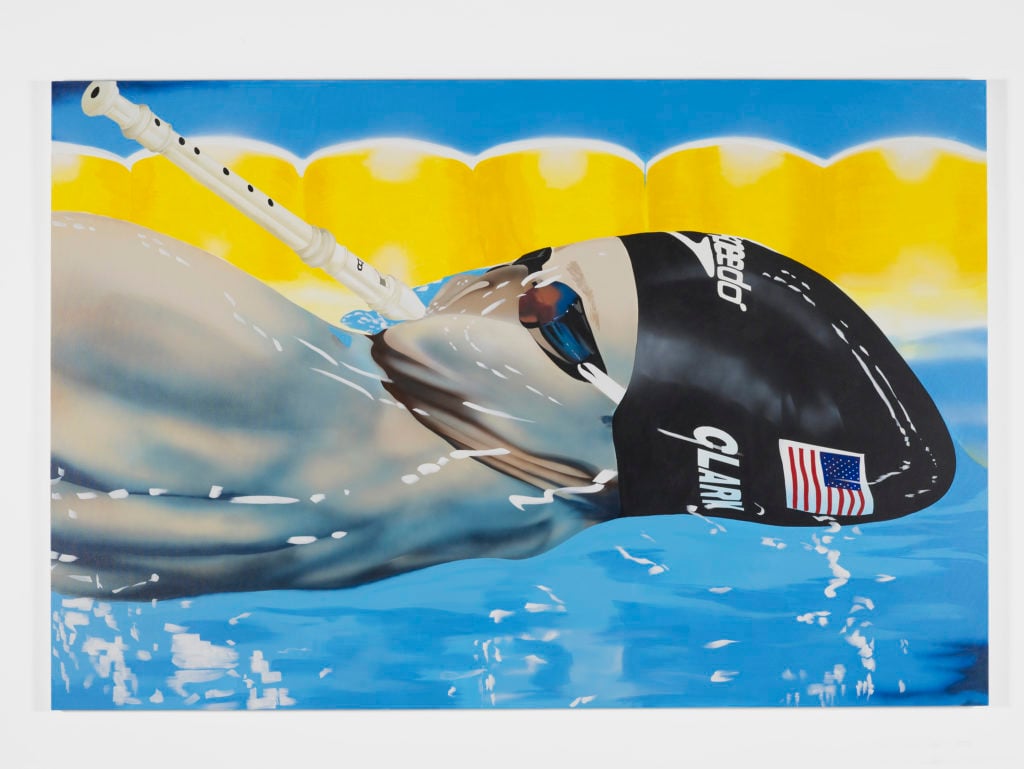
Jamian Juliano-Villani, The Sirens (2016). Image courtesy JTT.
Like many mid-sized dealers, you’ve also lost a few important artists who have moved on to dealers with deeper pockets and greater resources (Jamian Juliano-Villani, Issy Wood). How have you compensated for those losses both financially and personally?
I’ll just speak to Jamian because we just did one solo show with Issy. With Jamian we did quite a lot. She is an incredibly successful artist but I’m very proud to say that we have done well with a number of our artists, and we’ve brought on new artists, too. Finances are never what they appear from the outside.
What would you say to other dealers if one of their star artists just decided to join another gallery?
If me and another dealer are on the phone, it’s probably because we’re friends. So we’ll be getting into it, and talking about our feelings. This job requires a lot of vulnerability and both the artist and the dealer have to feel like they can be vulnerable in order to be successful. If either the artist or the dealer doesn’t, it makes a lot of sense to part ways. If I was speaking to a friend I would say “how can I help you feel okay in this moment?” Because it’s painful stuff!
More broadly, what do you think about the sustainability of this system, where artists gain in market value and prominence and move on to larger dealers? Is it sustainable? If not, how do we change it?
I think there are two questions within this question. One is about what’s happening in the larger art market and the other about what’s happening at JTT. We are going to be sustainable—that I know—I know what’s going on, I know my next two years, I know what artists have planned, which shows I have planned, and I’m very excited about that.
The other side is regarding what’s going on in the market, I have a harder time answering that question. I think there are going to be a lot of shifts in the next five to 10 years where a lot of younger artists are going to move to bigger galleries. One of the big issues is the economy and inflation; young artists have more pressure just to survive. They’re going to need a lot of financial support, and younger galleries are going to have to learn to sustain that support. Institutions are going to put a lot more pressure on [younger] galleries to support them. It’s very important for galleries to solve those problems.
